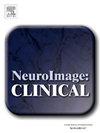使用可解释的人工智能对白质高信号的认知影响进行个体化病变-症状映射
IF 3.4
2区 医学
Q2 NEUROIMAGING
引用次数: 0
摘要
病变症状映射方法评估脑血管疾病引起的病变与认知之间的关系,但目前的技术(如支持向量回归(SVR))主要提供组水平的结果。我们提出了一种新的病变-症状映射方法,可以表明病变模式如何在个体水平上导致认知障碍。卷积神经网络(CNN)预测认知评分,并结合可解释的人工智能(XAI)来绘制认知与血管病变之间的关系。该方法主要使用821名记忆门诊患者的真实白质高强度图和模拟认知数据,以及加权病变和噪音水平来评估。模拟数据提供了地面真实位置,以评估CNN的预测性能和XAI战略性病变识别的准确性,使用已建立的病变症状映射方法SVR和简单的全连接神经网络(FNN)作为基准。真实认知得分被用于最后的原理证明分析。在仿真实验中,CNN (R2 = 0.964)、SVR (R2 = 0.875)和FNN (R2 = 0.863)的预测性能较高。CNN与XAI一起提供了患者特定的归因地图,突出显示了地面真实位置。所有方法对噪声的敏感性相似。使用真实认知评分,SVR (R2 = 0.291)获得的预测性能略高于CNN (R2 = 0.216),尽管这两种方法都大大超过了单独使用总WMH体积的预测性能(R2 = 0.013)。FNN在真实数据上表现较差(R2 = 0.020)。综上所述,结果表明,cnn结合XAI可以进行病变-症状映射并生成个体归因图,这可能是进一步开发方法的一个有价值的特征。本文章由计算机程序翻译,如有差异,请以英文原文为准。

Individualized lesion-symptom mapping using explainable artificial intelligence for the cognitive impact of white matter hyperintensities
Lesion-symptom mapping methods assess the relationship between lesions caused by cerebral small vessel disease and cognition, but current technology like support vector regression (SVR)) primarily provide group-level results. We propose a novel lesion-symptom mapping approach that can indicate how lesion patterns contribute to cognitive impairment on an individual level. A convolutional neural network (CNN) predicts cognitive scores and is combined with explainable artificial intelligence (XAI) to map the relation between cognition and vascular lesions.
This method was evaluated primarily using real white matter hyperintensity maps of 821 memory clinic patients and simulated cognitive data, with weighted lesions and noise levels. Simulated data provided ground truth locations to assess predictive performance of the CNN and accuracy of strategic lesion identification by XAI, using an established lesion-symptom mapping method, SVR, and a simple fully connected neural network (FNN) as benchmarks. Real cognitive scores were used in a final proof-of-principle analysis.
Predictive performance in simulation experiments was high for the CNN (R2 = 0.964), SVR (R2 = 0.875), and FNN (R2 = 0.863). CNN with XAI provided patient-specific attribution maps that highlighted the ground truth locations. All methods showed similar sensitivity to noise. Using real cognitive scores, SVR (R2 = 0.291) obtained a somewhat higher predictive performance than the CNN (R2 = 0.216), although both methods substantially exceeded the predictive performance of total WMH volume alone (R2 = 0.013). The FNN performed worse on real data (R2 = 0.020).
To conclude, results show that CNNs combined with XAI can perform lesion-symptom mapping and generate individual attribution maps, which could be a valuable feature with further method development.
求助全文
通过发布文献求助,成功后即可免费获取论文全文。
去求助
来源期刊

Neuroimage-Clinical
NEUROIMAGING-
CiteScore
7.50
自引率
4.80%
发文量
368
审稿时长
52 days
期刊介绍:
NeuroImage: Clinical, a journal of diseases, disorders and syndromes involving the Nervous System, provides a vehicle for communicating important advances in the study of abnormal structure-function relationships of the human nervous system based on imaging.
The focus of NeuroImage: Clinical is on defining changes to the brain associated with primary neurologic and psychiatric diseases and disorders of the nervous system as well as behavioral syndromes and developmental conditions. The main criterion for judging papers is the extent of scientific advancement in the understanding of the pathophysiologic mechanisms of diseases and disorders, in identification of functional models that link clinical signs and symptoms with brain function and in the creation of image based tools applicable to a broad range of clinical needs including diagnosis, monitoring and tracking of illness, predicting therapeutic response and development of new treatments. Papers dealing with structure and function in animal models will also be considered if they reveal mechanisms that can be readily translated to human conditions.
 求助内容:
求助内容: 应助结果提醒方式:
应助结果提醒方式:


